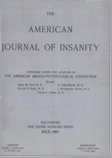PSYCHOPATHOLOGY OF STUTTERING
Abstract
The speech structures are described from the point of view of their relation to the upper respiratory and upper digestive tract. Their utilization in the finely co-ordinated function of speech is also described. The stuttering disorder is defined, and the predominance of tonic or clonic features is emphasized. Associated movements, respiratory and vasomotor disturbances are included. The theories of the etiology of stuttering are reviewed. The findings of a detailed clinical study of 15 cases of stuttering in children are summarized, and the psychodynamic factors analyzed. One typical case is presented from the point of view of anamnestic data, etiology, treatment and course. The importance of maternal neurotic attitudes in the early eating-speaking situation where the transfer of functions of oral structures attains is brought out. Other developmental phases coincident with the period of this early eating-speaking situation are studied from the point of view of contributing factors.
Access content
To read the fulltext, please use one of the options below to sign in or purchase access.- Personal login
- Institutional Login
- Sign in via OpenAthens
- Register for access
-
Please login/register if you wish to pair your device and check access availability.
Not a subscriber?
PsychiatryOnline subscription options offer access to the DSM-5 library, books, journals, CME, and patient resources. This all-in-one virtual library provides psychiatrists and mental health professionals with key resources for diagnosis, treatment, research, and professional development.
Need more help? PsychiatryOnline Customer Service may be reached by emailing [email protected] or by calling 800-368-5777 (in the U.S.) or 703-907-7322 (outside the U.S.).



